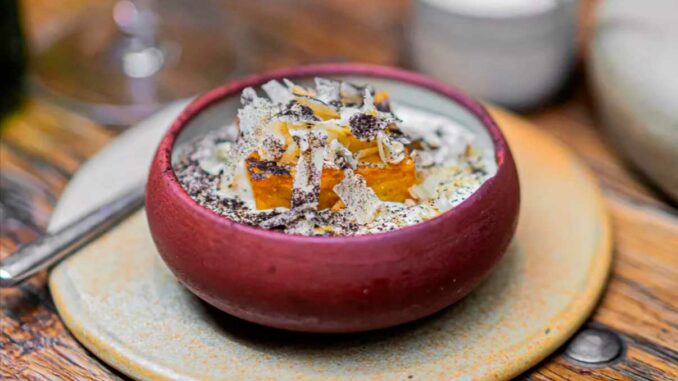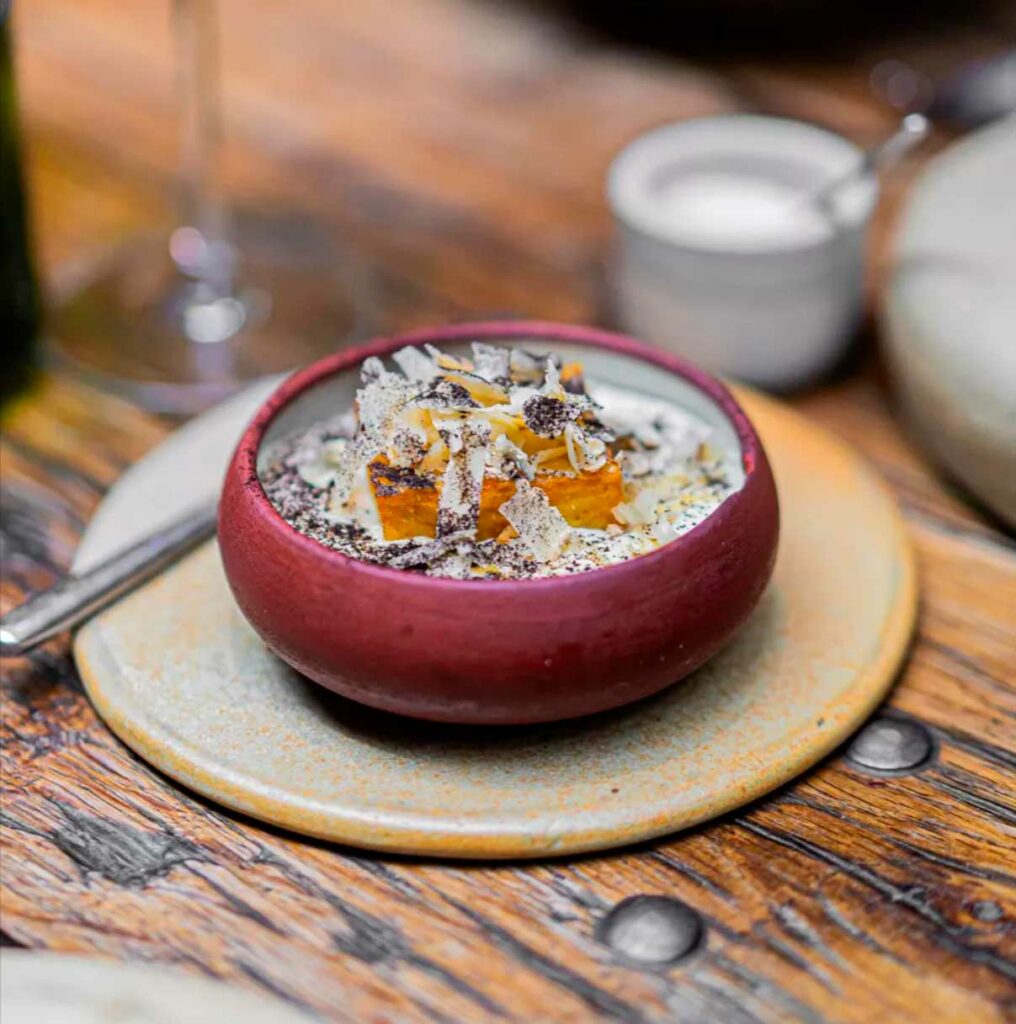
Discover Lille’s food culture — from carbonnade flamande and Maroilles cheese to inventive restaurants redefining northern French cuisine with local, modern flair.
Lille’s culinary identity tells the story of a region caught between tradition and transformation. Long defined by hearty northern French food—beef stews, beer-based sauces, strong cheeses, and rustic desserts—the city has recently evolved into a laboratory of contemporary cooking. Its chefs now champion local ingredients, short supply chains, and lighter, creative techniques that renew the flavors of Flanders without denying their origins. From the dense comfort of a carbonnade flamande to the refined tasting menus of Bloempot or Rozo, Lille offers a spectrum of experiences that reflect both its working-class past and its confident gastronomic present.
The Traditional Cuisine of Lille: Generosity and Grit
A culinary identity forged by weather and work
Traditional Lille cuisine emerged from the land’s harsh climate and industrial history. This is food built to sustain: slow-cooked, generous, rich in calories and character. Root vegetables, butter, beer, and Maroilles cheese form the foundations of a cuisine that once fed miners, farmers, and factory workers. Its simplicity is deceptive—these recipes require time, patience, and balance. The emblematic carbonnade flamande, for instance, turns cheap cuts of beef into melting tenderness through hours of simmering in brown ale.
Carbonnade flamande: beer, beef, and bread
No dish captures the soul of Lille quite like the carbonnade. Made from beef shoulder or chuck, cooked gently in brown beer such as Ch’ti Ambrée or 3 Monts, and thickened with mustard and gingerbread, it’s both sweet and savory. Traditionally served with hand-cut fries fried in beef fat, a carbonnade in a local estaminet costs around €16. It embodies the region’s dual influences—French slow cooking and Flemish beer gastronomy. The flavors are caramelized, deep, and faintly bitter, softened by onions and the sweetness of the bread.
Potjevleesch and the art of preservation
If the carbonnade represents warmth, potjevleesch represents preservation. Meaning “pot of meat” in Flemish, it’s a chilled terrine of rabbit, pork, and chicken set in jelly with vinegar and herbs. Originally a farmhouse way to extend meat supplies through summer, it’s now a brasserie classic, served with fries and salad for about €14. Its tangy acidity and delicate texture provide a welcome counterpoint to the richer stews of winter.
Cheese, butter, and the Maroilles legacy
Cheese is the other cornerstone of northern cuisine. The famous Maroilles, an AOP cow’s milk cheese from Thiérache, features everywhere—melted in sauces, baked into tarts, or eaten plain with dark bread. The tarte au Maroilles, with its yeasted dough and intense aroma, costs around €3.50 a slice in bakeries and about €12 in restaurants. Its bold, fermented tang is balanced by the dough’s buttery softness. Alongside it, one finds dishes like Welsh rarebit à la française, where beer-melted cheese covers ham and toast, sometimes crowned with a fried egg. Hearty, unapologetic, and calorically robust, this dish—around €15 per plate—illustrates how northern cooks transform simple ingredients into comfort food with attitude.
Sweet endings: waffles, sugar, and spice
Dessert in Lille is no lighter. The gaufre fourrée Meert, a thin waffle filled with vanilla buttercream, has been the city’s signature since 1761. Sold at €2.90 each in the historic Meert boutique, it remains a local obsession and a traveler’s souvenir. Other sweets like tarte au sucre, bêtises de Cambrai, and pain d’épices carry the same rustic charm: sweetness as an act of preservation, not indulgence. Each tells of a northern palate shaped by scarcity, weather, and resilience.
This traditional repertoire—rich, rooted, resistant—defines the base of Lille’s culinary identity. Yet over the past fifteen years, a quiet revolution has modernized these flavors without erasing their soul.


The New Lille: Modern Technique Meets Local Terroir
A new generation of chefs
In the 2010s, Lille’s kitchens began to shift. A younger wave of chefs started revisiting regional products with lighter techniques, sharper acidity, and minimalist plating. They didn’t reject tradition—they dissected it. The catalyst was Florent Ladeyn, a Top Chef semi-finalist who opened Bloempot in 2013. Installed in a former carpentry workshop, his restaurant redefined terroir cuisine for the 21st century. The five-course tasting menu (€58) uses only local ingredients: endives roasted in hay, pickled leeks, trout from nearby Rieulay, and sourdough from northern grain. Ladeyn replaced butter with fermented cream and often pairs dishes with craft beer instead of wine. The result is raw, rustic elegance—gastronomy stripped of pretense yet full of precision.
Rozo: fine dining with Flemish DNA
A few streets away, Rozo, led by Charles Cuypers (formerly of Le Meurice), offers a different expression of modern northern cooking. Cuypers combines technical finesse with regional products: veal served with Maroilles foam and beetroot reduction, grilled salsify with hazelnut miso, or cod with smoked butter and sea herbs. Lunch menus start at €32, while the tasting experience reaches €78. The cellar holds 200 wines, but the beer list—featuring rare lambics and Trappist ales—confirms Lille’s cross-border sensibility. This is haute cuisine grounded in terroir, not detached from it.
Bistronomy and reinterpreted classics
Another emblematic address, La Laiterie in Lambersart, once held a Michelin star. Under chef Benoît Bernard, it now champions a bistronomic approach—technical cooking at relaxed prices. Dishes like Jerusalem artichoke purée with smoked eel and beet crisps show finesse without formality. A tasting menu costs €68, proving that creativity can thrive outside Paris. Many newer restaurants—Oxalis & Bergamote, La Luck, Bierbuik, and the young team at L’Empreinte—share this philosophy: local sourcing, vegetable-forward dishes, and clean flavors replacing the old butter-and-cream heaviness.
From sweets to craft beer
Even dessert and drinks have evolved. Pastry shops such as Aux Merveilleux de Fred export Lille’s reimagined merveilleux—a light dome of meringue, whipped cream, and chocolate shavings—across Europe. Meanwhile, the region’s breweries fuel a creative ecosystem. Brands like Célestin, Cambier, and Page 24 lead a new craft beer movement that complements the city’s neo-bistro scene, offering pairings once reserved for wine. These shifts have made Lille one of France’s most dynamic mid-sized cities for food innovation.
A Dual Food Scene: Heritage and Experimentation
Two Lilles at the table
Walk through Lille’s old town and you’ll encounter two culinary worlds coexisting. In traditional estaminets, diners still order carbonnade, potjevleesch, and tarte au Maroilles by habit. The wooden tables, lace curtains, and chalkboard menus feel untouched by time. Yet a few blocks away, the dining rooms glow with modern restraint—concrete, linen, ceramics, open kitchens. Here, chefs weigh every gram of vinegar and plate endive petals like origami. Both sides tell Lille’s story: one of continuity and curiosity. Locals move between them freely—comfort one week, discovery the next.
The economics of appetite
This coexistence reflects not just taste but economics. Traditional restaurants offer abundant meals for €15 to €25, aligned with local wages. The new gastronomy, while celebrated, remains more exclusive: tasting menus above €70 test the limits of accessibility in a city with a strong working-class heritage. Still, demand grows. The proximity to Brussels, Paris, and London brings in weekend visitors who expect fine dining. This mix of local loyalty and external curiosity keeps Lille’s restaurants full and its culinary identity evolving.
Sourcing and sustainability
Both old and new chefs now face the same challenge: sustainability. Producers around Lille increasingly supply both traditional and avant-garde kitchens. Small farms in Flandre Intérieure deliver vegetables and grains; artisanal dairies provide raw-milk cheeses; fish farms in Rieulay and Saint-Amand-les-Eaux source trout and perch. Even in classic stews, more cooks replace industrial beer with local craft breweries. Farmers’ markets like Wazemmes and Saint-Sauveur showcase the same trend—shorter supply chains, fewer imports, better traceability. Lille’s transformation is ecological as much as culinary.
The Regional Pantry: Ingredients that Define the North
Beer: the backbone of flavor
In the Hauts-de-France, beer is not only a drink—it’s a cooking medium, a pairing, and a source of pride. Breweries such as Brasserie du Pays Flamand and La Choulette supply amber ales and stouts that lend depth to sauces, marinades, and desserts. The bitter-sweet notes of brown beer anchor many stews, while lighter blondes brighten batters and vinaigrettes.
Maroilles and friends
Northern cheeses carry the terroir’s pungent soul. Maroilles, Vieux-Lille, and Boulettes d’Avesnes—washed-rind and assertive—are culinary signatures. Once symbols of rural poverty, they are now prized by chefs for their aromatic complexity. In new kitchens, Maroilles becomes a foam, a sauce base, or a fermented accent, proving how flexibility can modernize even the most rustic ingredients.
Endives, beets, and roots
The region’s vegetables—endive, beetroot, celeriac, leeks, and salsify—define its palate. Once dismissed as humble, they now lead dishes in their own right. Pickled, roasted, or fermented, these roots reflect Lille’s embrace of plant-forward gastronomy. In winter, their sweetness and acidity balance the region’s heavier proteins, from pork to duck.
Sweets and spirits
From gaufres Meert to gin de Flandre, northern desserts and spirits bridge past and present. Pastry chefs increasingly use local grains and seasonal fruit in lighter reinterpretations of old recipes. Distillers around Lille experiment with herb liqueurs and low-sugar aperitifs, reconnecting the region’s conviviality with modern wellness trends.


The Soul of Northern Cuisine
Lille’s food story captures a rare equilibrium between continuity and change. Its traditional dishes—dense with butter, beer, and patience—speak of a time when cooking was survival and pleasure intertwined. Its modern restaurants, precise and forward-looking, reinterpret those same ingredients through the lens of technique, terroir, and restraint. Together they form one of France’s most complete culinary ecosystems: authentic, inventive, and profoundly regional.
For travelers, what to eat in Lille is more than a checklist of carbonnade, tarte au Maroilles, and gaufres Meert. It’s an exploration of how a city feeds itself—how it honors its fields, its climate, its labor, and its appetite for evolution. Lille proves that northern French cuisine can be both rustic and refined, heavy in history yet light in spirit. Between the estaminet’s stew pot and the chef’s tasting plate lies the beating heart of the modern French table.
Cook in France is your independant source for food in France.